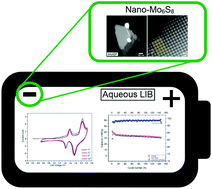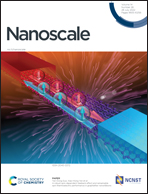Nanocubes of Mo6S8 Chevrel phase as active electrode material for aqueous lithium-ion batteries†
Abstract
The development of intrinsically safe and environmentally sustainable energy storage devices is a significant challenge. Recent advances in aqueous rechargeable lithium-ion batteries (ARLIBs) have made considerable steps in this direction. In parallel to the ongoing progress in the design of aqueous electrolytes that expand the electrochemically stable potential window, the design of negative electrode materials exhibiting large capacity and low intercalation potential attracts great research interest. Herein, we report the synthesis of high purity nanoscale Chevrel Phase (CP) Mo6S8via a simple, efficient and controllable molecular precursor approach with significantly decreased energy consumption compared to the conventional approaches. Physical characterization of the obtained product confirms the successful formation of CP-Mo6S8 and reveals that it is crystalline nanostructured in nature. Due to their unique structural characteristics, the Mo6S8 nanocubes exhibit fast kinetics in a 21 m lithium bis(trifluoromethanesulfonyl)imide (LiTFSI) electrolyte as a result of the shorter Li+ ion diffusion distance. Full battery cells comprised of Mo6S8 and LiMn2O4 as negative and positive electrode materials, respectively, operate at 2.23 V delivering a high energy density of 85 W h kg−1 (calculated on the total mass of active materials) under 0.2 C-rate. At 4 C, the coulombic efficiency (CE) is determined to be 99% increasing to near 100% at certain cycles. Post-mortem physical characterization demonstrates that the Mo6S8 anode maintained its crystallinity, thereby exhibiting outstanding cycling stability. The cell outperforms the commonly used vanadium-based (VO2 (B), V2O5) or (NASICON)-type LiTi2(PO4)3 anodes, highlighting the promising character of the nanoscale CP-Mo6S8 as a highly efficient anode material. In summary, the proposed synthetic strategy is expected to stimulate novel research towards the widespread application of CP-based materials in various aqueous and non-aqueous energy storage systems.



 Please wait while we load your content...
Please wait while we load your content...